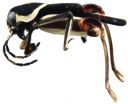(Press-News.org) Astronomers using NASA's Hubble Space Telescope have found a cluster of young, blue stars encircling the first intermediate-mass black hole ever discovered. The presence of the star cluster suggests that the black hole was once at the core of a now-disintegrated dwarf galaxy. The discovery of the black hole and the star cluster has important implications for understanding the evolution of supermassive black holes and galaxies.
"For the first time, we have evidence on the environment, and thus the origin, of this middle-weight black hole," said Mathieu Servillat, who worked at the Harvard-Smithsonian Center for Astrophysics when this research was conducted.
Astronomers know how massive stars collapse to form stellar-mass black holes (which weigh about 10 times the mass of our sun), but it's not clear how supermassive black holes (like the four million solar-mass monster at the center of the Milky Way) form in the cores of galaxies. One idea is that supermassive black holes may build up through the merger of smaller, intermediate-mass black holes weighing hundreds to thousands of suns.
Lead author Sean Farrell, of the Sydney Institute for Astronomy in Australia, discovered this unusual black hole in 2009 using the European Space Agency's XMM-Newton X-ray space telescope. Known as HLX-1 (Hyper-Luminous X-ray source 1), the black hole weighs in at 20,000 solar masses and lies towards the edge of the galaxy ESO 243-49, which is 290 million light-years from Earth.
Farrell and his team then observed HLX-1 simultaneously with NASA's Swift observatory in X-ray and Hubble in near-infrared, optical, and ultraviolet wavelengths. The intensity and the color of the light shows a cluster of young stars, 250 light-years across, encircling the black hole. Hubble can't resolve the stars individually because the suspected cluster is too far away. The brightness and color are consistent with other clusters of young stars seen in other galaxies.
Farrell's team detected blue light from hot gas in the accretion disk swirling around the black hole. However, they also detected red light produced by much cooler gas, which would most likely come from stars. Computer models suggested the presence of a young, massive cluster of stars encircling the black hole.
"What we can definitely say with our Hubble data is that we require both emission from an accretion disk and emission from a stellar population to explain the colors we see," said Farrell.
Such young clusters of stars are commonly seen in nearby galaxies, but not outside the flattened starry disk, as found with HLX-1. The best explanation is that the HLX-1 black hole was the central black hole in a dwarf galaxy. The larger host galaxy then captured the dwarf. Most of the dwarf's stars were stripped away through the collision between the galaxies. At the same time, new young stars were formed in the encounter. The interaction that compressed the gas around the black hole also triggered star formation.
Farrell and Servillat found that the star cluster must be less than 200 million years old. This means that the bulk of the stars were formed following the dwarf's collision with the larger galaxy. The age of the stars tells how long ago the two galaxies crashed into each other.
The future of the black hole is uncertain at this stage. It depends on its trajectory, which is currently unknown. It's possible the black hole may spiral in to the center of the big galaxy and eventually merge with the supermassive black hole there. Alternately, the black hole could settle into a stable orbit around the galaxy. Either way, it's likely to fade away in X-rays as it depletes its supply of gas.
"This black hole is unique in that it's the only intermediate-mass black hole we've found so far. Its rarity suggests that these black holes are only visible for a short time," said Servillat.
More observations are planned this year to track the history of the interaction between the two galaxies.
INFORMATION:
Black hole came from a shredded galaxy
2012-02-16
ELSE PRESS RELEASES FROM THIS DATE:
Plasmas torn apart
2012-02-16
VIDEO:
An argon plasma jet forms a rapidly growing corkscrew, known as a kink instability. This instability causes an even faster-developing behavior called a Rayleigh-Taylor instability, in which ripples grow and...
Click here for more information.
PASADENA, Calif.—January saw the biggest solar storm since 2005, generating some of the most dazzling northern lights in recent memory.
The source of that storm—and others like it—was the sun's magnetic field, described by ...
Tool assessing how community health centers deliver 'medical home' care may be flawed
2012-02-16
On the health front, the poor often have at least two things going against them: a lack of insurance and chronic illnesses, of which diabetes is among the most common.
The federal Affordable Care Act would expand the capacity of the nation's 8,000 community health centers to provide care for low-income, largely minority patients — from the current 20 million to about 40 million by 2015. The federal government is also trying to ensure that these community health centers deliver high-quality primary care, including diabetes care.
A crucial part of this is the implementation ...
Astronomers watch delayed broadcast of a rare celestial eruption
2012-02-16
Pasadena, CA— Eta Carinae, one of the most massive stars in our Milky Way galaxy, unexpectedly increased in brightness in the 19th century. For ten years in the mid-1800s it was the second-brightest star in the sky. (Now it is not even in the top 100.) The increase in luminosity was so great that it earned the rare title of Great Eruption. New research from a team including Carnegie's Jose Prieto, now at Princeton University, has used a "light echo" technique to demonstrate that this eruption was much different than previously thought. Their work is published Feb. 16 in ...
Contraceptive preferences among young Latinos related to sexual decision-making
2012-02-16
CORVALLIS, Ore. – Half of the young adult Latino men and women responding to a survey in rural Oregon acknowledge not using regular effective contraception – despite expressing a desire to avoid pregnancy, according to a new Oregon State University study.
Researchers say the low rate of contraception among sexually active 18- to 25-year-olds needs to be addressed – and not just among Latino populations. Research has shown many young adults from all backgrounds eschew contraception for many reasons including the mistaken belief that they or their partners cannot get pregnant.
"The ...
Complexities in caregiving at the end of life
2012-02-16
Faced with the inevitability of death, we all wish for good caregiving during the final stage of our lives. A new study from Karolinska Institutet and Umeå University shows that non-pharmacological caregiving at the end of life in specialized palliative care is not as basic as one might believe but is based on complex professional decisions that weave physical, psychosocial and existential dimensions into a functional whole. The researchers have found that particularly important aspects of palliative care are an aesthetically pleasing, safe and comfortable environment, ...
New miniature grasshopper-like insect is first member of its family from Belize
2012-02-16
Scientists at the University of Illinois, USA have discovered a new species of tiny, grasshopper-like insect in the tropical rainforests of the Toledo District in southern Belize. Dr Sam Heads and Dr Steve Taylor co-authored a paper, published in the open access journal ZooKeys, documenting the discovery and naming the new species Ripipteryx mopana. The name commemorates the Mopan people – a Mayan group, native to the region.
"Belize is famous for its biodiversity, although very little is known about the insect fauna of the southern part of the country. This is particularly ...
Research highlights urgent need to tackle low number of organ donors from BME communities
2012-02-16
There is an urgent need to increase the number of organ donors from black and minority ethnic (BME) groups in countries with a strong tradition of immigration, such as the UK, USA, Canada and the Netherlands, in order to tackle inequalities in access and waiting times.
That is the key finding of a research paper on ethnicity and transplants, published by the Journal of Renal Care in a free online supplement that includes 15 studies on different aspects of diabetes and kidney disease.
"BME groups are disproportionately affected by kidney problems for a number of ...
Green spaces reduce stress levels of jobless, study shows
2012-02-16
Stress levels of unemployed people are linked more to their surroundings than their age, gender, disposable income, and degree of deprivation, a study shows.
The presence of parks and woodland in economically deprived areas may help people cope better with job losses, post traumatic stress disorder, chronic fatigue and anxiety, researchers say.
They found that people's stress levels are directly related to the amount of green space in their area – the more green space, the less stressed a person is likely to be.
Researchers measured stress by taking saliva samples ...
Low-carbon technologies 'no quick-fix', say researchers
2012-02-16
A drastic switch to low carbon-emitting technologies, such as wind and hydroelectric power, may not yield a reduction in global warming until the latter part of this century, research published today suggests.
Furthermore, it states that technologies that offer only modest reductions in greenhouse gases, such as the use of natural gas and perhaps carbon capture and storage, cannot substantially reduce climate risk in the next 100 years.
The study, published today, Thursday 16 February, in IOP Publishing's journal Environmental Research Letters, claims that the rapid ...
Stretching helices help keep muscles together
2012-02-16
VIDEO:
When myomesin is pulled, as it is when muscles contract and extend, its helices (green) unfold. This strategy, discovered by scientists at EMBL Hamburg, enables the elastic part of the...
Click here for more information.
In this video, a protein called myomesin does its impression of Mr. Fantastic, the leader of the Fantastic Four of comic book fame, who performed incredible feats by stretching his body. Scientists at the European Molecular Biology Laboratory (EMBL) in ...


